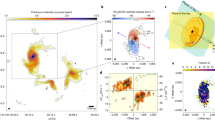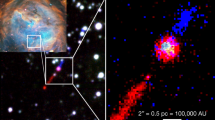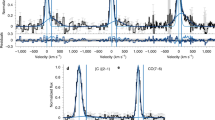Abstract
Solar-mass stars form via disk-mediated accretion. Recent findings indicate that this process is probably episodic in the form of accretion bursts1, possibly caused by disk fragmentation2,3,4. Although it cannot be ruled out that high-mass young stellar objects arise from the coalescence of their low-mass brethren5, the latest results suggest that they more likely form via disks6,7,8,9. It follows that disk-mediated accretion bursts should occur10,11. Here we report on the discovery of the first disk-mediated accretion burst from a roughly twenty-solar-mass high-mass young stellar object12. Our near-infrared images show the brightening of the central source and its outflow cavities. Near-infrared spectroscopy reveals emission lines typical for accretion bursts in low-mass protostars, but orders of magnitude more luminous. Moreover, the released energy and the inferred mass-accretion rate are also orders of magnitude larger. Our results identify disk-accretion as the common mechanism of star formation across the entire stellar mass spectrum.
This is a preview of subscription content, access via your institution
Access options
Subscribe to this journal
Receive 12 print issues and online access
$259.00 per year
only $21.58 per issue
Buy this article
- Purchase on SpringerLink
- Instant access to full article PDF
Prices may be subject to local taxes which are calculated during checkout



Similar content being viewed by others
References
Audard, M. et al. Episodic accretion in young stars. in Protostars and Planets VI (eds Beuther, H., Klessen, R., Dullemond, C. P. & Henning, T.) 387–410 (Univ. Arizona Press, 2014).
Kratter, K. M. & Matzner, C. D. Fragmentation of massive protostellar discs. Mon. Not. R. Astron. Soc. 373, 1563–1576 (2006).
Krumholz, M. R., Klein, R. I. & McKee, C. F. Radiation-hydrodynamic simulations of collapse and fragmentation in massive protostellar cores. Astrophys. J. 656, 959–979 (2007).
Vorobyov, E. I. & Basu, S. Variable protostellar accretion with episodic bursts. Astrophys. J. 805, A115 (2015).
Tan, J. C. et al. Massive star formation. in Protostars and Planets VI (eds Beuther, H., Klessen, R., Dullemond, C. P. & Henning, T.) 149–172 (Univ. Arizona Press, 2014).
Kuiper, R., Klahr, H., Beuther, H. & Henning, T. Three-dimensional simulation of massive star formation in the disk accretion scenario. Astrophys. J. 732, 1–11 (2011).
Klassen, M., Pudritz, R. E., Kuiper, R., Peters, T. & Benerjee, R. Simulating the formation of massive protostars. I. Radiative feedback and accretion disks. Astrophys. J. 823, A28 (2016).
Kraus, S. et al. A hot compact dust disk around a massive young stellar object. Nature 466, 339–342 (2010).
Caratti o Garatti, A. et al. Tracing jet emission at the base of a high-mass YSO. First AMBER/VLTI observations of the Brγ emission in IRAS 13481-6124. Astron. Astrophys. 589, L4 (2016).
Tan, J. C. & McKee, C. F. The formation of the first stars. I. Mass infall rates, accretion disk structure, and protostellar evolution. Astrophys. J. 603, 383–400 (2004).
Krumholz, M. R., Klein, R. I., McKee, C. F., Offner, S. S. R. & Cunningham, A. J. The formation of massive star systems by accretion. Science 323, 754–757 (2009).
Stecklum, B. et al. The methanol maser flare of S255IR and an outburst from the high-mass YSO S255IR-NIRS3—more than a coincidence? The Astronomer’s Telegram 8732, 1 (2016).
Zinchenko, I. et al. The disk-outflow system in the S255IR area of high-mass star formation. Astrophys. J. 810, A10 (2015).
Wang, Y. et al. Different evolutionary stages in the massive star-forming region S255 complex. Astron. Astrophys. 527, A32 (2011).
Burns, R. A., Handa, T., Nagayama, T., Sunada, K. & Omodaka, T. H2O masers in a jet-driven bowshock: episodic ejection from a massive young stellar object. Mon. Not. R. Astron. Soc. 460, 283–290 (2016).
Boley, P. A. et al. The VLTI/MIDI survey of massive young stellar objects. Sounding the inner regions around intermediate- and high-mass young stars using mid-infrared interferometry. Astron. Astrophys. 558, A24 (2013).
Fujisawa, K. et al. A flare of methanol maser in S255. The Astronomer’s Telegram 8286, 1 (2015).
Sobolev, A. M., Cragg, A. M. & Goodfrey, P. D. Pumping of Class II methanol masers. II. The 51 − 60 A+ transition. Astron. Astrophys. 433, 211–220 (1997).
Lorenzetti, D. et al. Near-infrared spectroscopic monitoring of EXor variables: first results. Astrophys. J. 693, 1056–1073 (2009).
Kóspál, Á. et al. Near-infrared spectroscopy of EX Lupi in outburst. Astrophys. J. 736, A72 (2011).
Caratti o Garatti, A. et al. LBT/LUCIFER near-infrared spectroscopy of PV Cephei. An outbursting young stellar object with an asymmetric jet. Astron. Astrophys. 693, A66 (2013).
Reipurth, B. & Aspin, C. Infrared spectroscopy of Herbig-Haro energy sources. Astron. J. 114, 2700–2707 (1997).
Contreras Peña, C. et al. Infrared spectroscopy of eruptive variable protostars from VVV. Preprint at http://arxiv.org/abs/1602.06269 (2016).
Hosokawa, T. & Omukai, K. Evolution of massive protostars with high accretion rates. Astrophys. J. 691, 823–846 (2009).
Hosokawa, T., Yorke, H. W. & Omukai, K. Evolution of massive protostars via disk accretion. Astrophys. J. 721, 478–492 (2010).
Bally, J. & Zinnecker, H. The birth of high-mass stars: accretion and/or mergers? Astron. J. 129, 2281–2293 (2005).
Krumholz, M. R., McKee, C. F. & Klein, R. I. How protostellar outflows help massive stars form. Astrophys. J. Lett. 618, 757–768 (2005).
Caratti o Garatti, A. et al. A near-infrared spectroscopic survey of massive jets towards extended green objects. Astron. Astrophys. 573, A82 (2015).
Hosokawa, T. et al. Formation of massive primordial stars: intermittent UV feedback with episodic mass accretion. Astrophys. J. 824, A119 (2016).
Baumeister, H. et al. PANIC: the new panoramic NIR camera for Calar Alto. SPIE 7014, 70142R (2008).
Greiner, J. et al. GROND—a 7-channel imager. Pub. Astron. Soc. Pac. 120, 405–424 (2008).
Skrutskie, M. F. et al. The two micron all sky survey (2MASS). Astron. J. 131, 1163–1183 (2006).
Landsman, W. B. The IDL Astronomy User’s Library. in Astronomical Data Analysis Software and Systems II (eds Hanisch, R. J., Brissenden, R. J. V. & Barnes, J.) 246–248 (A.S.P. Conference Series 52, 1993).
Adams, J. D. et al. FORCAST: a first light facility instrument for SOFIA. SPIE 7735, 77351U (2010).
Klein, R. et al. FIFI LS: the far-infrared integral field spectrometer for SOFIA. SPIE 6269, 62691F (2006).
Klein, R. et al. FIFI-LS: the facility far-infrared spectrometer for SOFIA. SPIE 9147, 8 (2014).
Longmore, S. N., Burton, M. G., Minier, V. & Walsh, A. J. Mid-infrared source multiplicity within hot molecular cores traced by methanol masers. Mon. Not. R. Astron. Soc. 369, 1196–1200 (2006).
Itoh, Y. et al. Near-infrared observations of S 255-2: The heart of a massive YSO cluster. Pub. Astron. Soc. Japan 369, 495–500 (2001).
Simpson, J. P. et al. Hubble space telescope NICMOS polarization observations of three edge-on massive young stellar objects. Astrophys. J. 700, 1488–1501 (2009).
Draine, B. Scattering by interstellar dust grains. I. Optical and ultraviolet. Astrophys. J. 598, 1017–1025 (2003).
Whitney, B. A., Wood, K., Bjorkman, J. E. & Wolff, M. J. Two-dimensional radiative transfer in protostellar envelopes. I. Effects of geometry on class I sources. Astrophys. J. 591, 1049–1063 (2003).
Eisenhauer, F. et al. SINFONI—Integral field spectroscopy at 50 milli-arcsecond resolution with the ESO VLT. SPIE 4841, 1548–1561 (2003).
McGregor, P. J. et al. Gemini near-infrared integral field spectrograph (NIFS). SPIE 4841, 1581–1591 (2003).
Modigliani, A. et al. The SINFONI pipeline ArXiv Astrophysics e-prints 0701297, 10 (2007).
Lorenzetti, D. et al. Interpreting the simultaneous variability of near-IR continuum and line emission in young stellar objects. Ap&SS 343, 535–539 (2013).
Deb, N. C. & Hibbert, A. log gf values for astrophysically important transitions Fe II. Astron. Astrophys. 561, A32 (2014).
Rieke, G. H. & Lebofsky, M. J. The interstellar extinction law from 1 to 13 microns. Astrophys. J. 288, 618–621 (1985).
Acknowledgements
A.C.o.G., R.G.L. and T.P.R. were supported by Science Foundation Ireland, grant 13/ERC/I2907. A.S. was supported by the Deutsche Forschungsgemeinschaft (DFG) Priority Program 1573. We thank the ESO Paranal and Gemini Observatory staff for their support. B.S. thanks Sylvio Klose for helpful discussions concerning the light echo. This research is partly based on observations collected at the VLT (ESO Paranal, Chile) with programme 296.C-5037(A) and at the Gemini Observatory (Program ID GN-2016A-DD-5). Gemini Observatory is operated by the Association of Universities for Research in Astronomy, under a cooperative agreement with the NSF on behalf of the Gemini partnership: the National Science Foundation (United States), the National Research Council (Canada), CONICYT (Chile), Ministerio de Ciencia, Tecnología e Innovación Productiva (Argentina), and Ministério da Ciência, Tecnologia e Inovação (Brazil).
Author information
Authors and Affiliations
Contributions
A.C.o.G., B.S. and R.G.L. wrote the initial manuscript and worked on the data reduction and analysis. R.G.L. supported SINFONI observations. A.C.o.G., B.S. and J.E. are the principal investigators of the ESO, Calar Alto, the Gemini, and the SOFIA proposals, respectively. A.S., R.C. and L.M. worked on the maser and radio data. T.P.R., A.S., R.C., L.M., C.M.W., R.D.O. and W.J.d.W. are coauthors of the proposals. J.G. provided GROND data. A.K., C.F. and R.K. supported SOFIA observations. J.M.I. supported PANIC observations. All coauthors commented on the manuscript.
Corresponding author
Ethics declarations
Competing interests
The authors declare no competing financial interests.
Rights and permissions
About this article
Cite this article
Caratti o Garatti, A., Stecklum, B., Garcia Lopez, R. et al. Disk-mediated accretion burst in a high-mass young stellar object. Nature Phys 13, 276–279 (2017). https://doi.org/10.1038/nphys3942
Received:
Accepted:
Published:
Issue date:
DOI: https://doi.org/10.1038/nphys3942
This article is cited by
-
Magnetic reconnection as the driving factor behind high-mass protostellar luminosity flares
Communications Physics (2025)
-
A Keplerian disk with a four-arm spiral birthing an episodically accreting high-mass protostar
Nature Astronomy (2023)
-
Snapshot of a magnetohydrodynamic disk wind traced by water maser observations
Nature Astronomy (2022)
-
New maser species tracing spiral-arm accretion flows in a high-mass young stellar object
Nature Astronomy (2020)
-
Zooming in on Individual Star Formation: Low- and High-Mass Stars
Space Science Reviews (2020)



